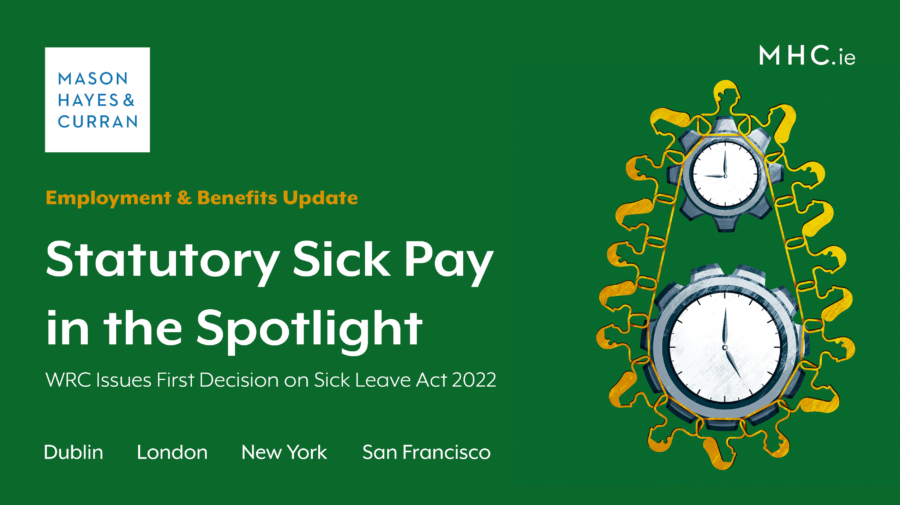Statutory Sick Pay in the Spotlight
WRC issues first decision on Sick Leave Act 2022

A recent WRC decision has provided the first analysis on whether the benefit provided by a company sick pay scheme was, as a whole, more favourable to an employee than an entitlement to statutory sick pay. Our Employment & Benefits Law team analyses the likely impact for employers.
The outcome of a recent case before the Workplace Relations Commission provides us with a first look at the WRC’s approach to whether a company sick pay scheme is, on the whole, more favourable to an employee than their entitlement to statutory sick pay. Although this is the first time this legal point has been raised, it is illustrative for employers and legal practitioners as to how the WRC may approach this question under the Sick Leave Act 2022.
Background
The case concerned a shop assistant who was absent due to illness for four days in 2023 and claimed that she was entitled to statutory sick pay. Her employer operated a sick pay scheme (the employer’s scheme) which offered eight weeks' paid sick leave, but importantly, it excluded the first three days of sickness absence.
Section 9 of the Sick Leave Act 2022 provides that the obligations under the Act will not apply to an employer who provides a sick leave scheme where the terms of the scheme are, over a reference period in the scheme, as a whole, more favourable to the employee than statutory sick leave. Section 9 outlines what is to be taken into consideration when determining if an employer’s scheme is more favourable than an entitlement to statutory sick pay.
Statutory sick pay versus the employer’s scheme – five considerations
Consideration |
Statutory sick pay |
Employer’s scheme |
The period of service of an employee that is required before sick leave is payable |
13 weeks |
6 months |
The number of days that an employee is absent before sick leave is payable |
Sick leave is payable on day 1 |
Sick leave is payable after 3 days |
The period for which sick leave is payable |
3 days |
8 weeks |
The amount of sick leave that is payable |
70% of wages *Capped at a daily maximum of €110 |
Full wage *Less any illness benefit that may be payable |
The reference period of the sick leave scheme |
N/A |
Rolling 12-month period |
The employer acknowledged that statutory sick pay is more favourable than its own sick leave scheme in some respects, given the required length of service, 13 weeks v 26 weeks, and the fact that days 1 to 3 are paid.
However, the employer argued these differences were minor and were outweighed by the benefits in its scheme as a whole. The WRC agreed and concluded that the duration of paid sick leave in the employer’s sick pay scheme, coupled with the amount of sick pay provided, outweighed any negatives derived from a 3-day “waiting period” and the requirement to have 6 months continuous service to avail of the employer’s scheme. The WRC did not deem the application of a “waiting period” to be unreasonable and noted that this was consistent with the same conditions attached to the payment of Illness Benefit and was followed by most employer schemes.
Industrial relations consideration
Interestingly, the employer in this case asked the WRC to consider that its sick pay scheme arose from a collective bargaining process. It was submitted that a policy objective of the WRC is to facilitate collective bargaining and that deciding that statutory sick pay was more favourable would destabilise industrial relations in the business. The WRC acknowledged that the employer’s scheme emerged from collective bargaining and that its design includes a provision that discourages short-term absences. The WRC noted that the parties had not initiated any discussions to change this policy as a result of the Sick Leave Act 2022.
Conclusion
This case provides a useful guide for employers as to what exactly should be considered when determining if their sick pay scheme is, as a whole, more favourable than statutory sick pay. The case also provides some comfort to employers who incorporate “waiting days” into their sick pay scheme. As the case law on this legal point is currently limited to this single case, prudent employers should keep abreast of further WRC decisions likely to follow which grapple with the provisions of the Sick Leave Act 2022.
For more information and expert advice on managing your organisation’s sick pay scheme, please contact a member of our Employment & Benefits team.
People also asked
What are my entitlements to statutory sick pay? |
Under the Sick Leave Act 2022, employees will have the following statutory entitlements over a four-year period: • 3 days statutory sick pay in 2023 • 5 days statutory sick pay in 2024 • 7 days statutory sick pay in 2025 • 10 days statutory sick pay in 2026 |
How do I qualify for statutory sick pay? |
Employees must have a minimum of 13 weeks’ continuous service for the company and must provide their employer with an appropriate medical certificate. |
Will statutory sick pay cover a full day of pay? |
Sick pay will be set at 70% of the employee’s wage and this will be capped at a daily maximum of €110. |
The content of this article is provided for information purposes only and does not constitute legal or other advice.
Share this:




